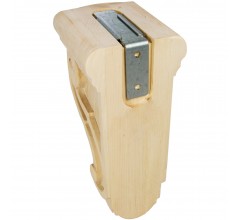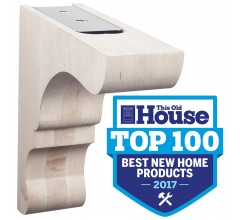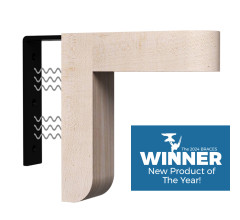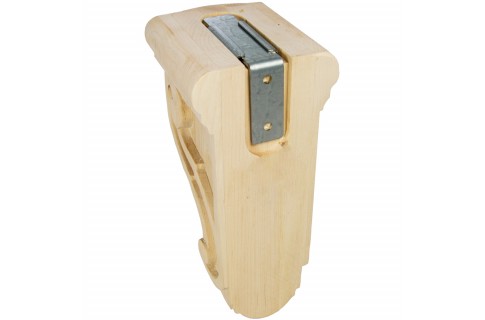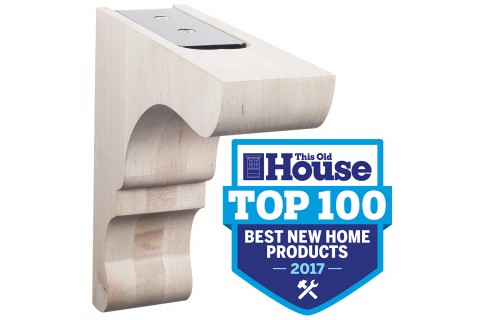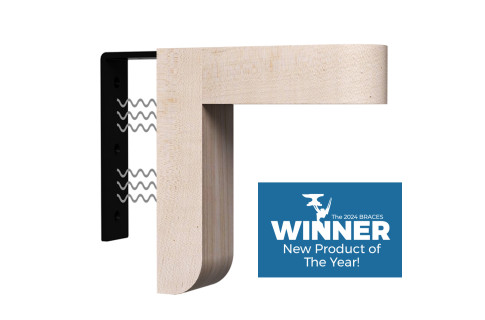Wood Corbels
Wood Corbels
Decorative wood corbels have long been a staple in home design. Federal Brace innovated the beloved wood corbel with our mounting system that adds a weight-bearing function. Expanding on the weight-bearing design, we developed wood corbels with a rib mount system, which gives each corbel a carrying capacity of up to 375 pounds when installed in a stud or blocking. Read more...
Wood Corbel Product Categories
Click on the categories below to view products:Subcategories
Weight-Bearing Wood Corbels
Corbels are a familiar sight in both architecture and interior design, often seen supporting structures or adding decorative detail to a space. These functional and ornamental elements can be found under shelves, countertops, fireplace mantels, and even kitchen islands, where they provide both support and style.
Throughout history, corbels have been integral to architecture, dating back to ancient Babylonian times. In Italy and France, they were often used under balconies, where their grand size and intricate carvings served both a practical purpose and an aesthetic one. Today, wood corbels continue to enhance spaces by combining strength with design, making them a timeless choice in homes and buildings.
Wherever weight-bearing wood corbels are required, there are several options for the installer. In some instances a block of wood may be used and tied into the substructure, then a thinner carved overlay is placed on the wood for a faux wood corbel.
Another possibility is to use a steel support bracket installed to support the weight. In this application, the wood corbel requires a routed cavity to cover the steel support bracket, which provides the desired decorative element.
In all cases, it is necessary to be sure the portion of the corbel that is carrying the load is installed into a stud framework that runs into the floor to disperse the weight and let the sleek design of the decorative wood corbel be the facade to disguise the support.
Federal Brace provides two mounting systems: our original corbel mount system, which is light duty and can be retrofitted or installed after final millwork completion, and the orbel rib systemc, which gives a weight-bearing capacity to a light-duty wood corbel. Whether you select one of our pre-routed corbels or select a mounting system to use on your corbel purchased elsewhere, you'll enjoy the traditional wood corbel look with the strength of metal.
Decorative & Rustic Wood Corbel Designs
Traditionally, a corbel’s design was projecting from within the wall to provide support. However, times have changed and so has the corbel. Today, wood corbels are fastened on as a simple decorative element with no weight-bearing capacity considerations.
We have several different rustic wood corbel designs available for you to choose from. Whether you’re looking for corbels to accent your mantle, countertop, or other applications, we have a decorative wood corbel to meet your needs.
Today’s wood corbels can be simple in design or ornately carved but are almost exclusively used as a decorative element (without significant weight-bearing ability). The majority of wood corbels available on the market have a keyhole mount on the back, non-visible, side of the corbel. The keyhole mounting format provides very limited weight-bearing capacity and is most often only sufficient for carrying the weight of the corbel itself. This keyhole also makes for a difficult mounting process and can result in the wood corbel not lining up properly under the desired element.
Federal Brace has wood corbel systems available in many designs that are routed and pre-fit with our corbel mounting systems. This makes mounting your wood corbel easier and eliminates the risk of splitting the corbel or matching stain to cover the mounting hole. These mounts also allow you to install your decorative wood corbel at the end of the project, which can protect them from potential damage during construction.
The Inovative Corbel Rib Support
Similar to the rib cage, which helps to hold the body’s organs in place, Federal Brace’s corbel fib support functions on the same principle. The corbel rib support maintains stability to prevent a flimsy, loose corbel installation. Wood corbels have long been attached using a screw installed through the corbel or inserted in a keyhole mount in the back. Both of these options have considerable flaws:
|
|
|
|---|---|
|
|
|
|
|
|
|
|
|
The corbel rib increases the support of a standard wood corbel by over 200 pounds, allowing it to be more than a mere decorative element. Each wood corbel installed with the corbel rib has a carrying capacity of up to 375 pounds when installed in a stud or blocking tied into the structure. Previously wood corbels could only be used for a fancy shelf, decorative mantelpiece, or under counter decor with little support, now using rib supports, they are significantly more functional, stronger, and more durable - even in high traffic areas.
Tips for Installing Wood Corbels
Determine if you are hanging or hard mounting. This will determine the next steps.
- Hanging will need to be completed pre-countertop, using keyhole mounts with no weight capacity.
- Hard mounting can be completed after the countertop is installed using various methods. Attaching from the back or using a fastener through a pre-drilled hole from the front, filling the hole with putty and finishing.
- The connection between the corbel and the wall. While fasteners are provided with the Federal Brace corbel rib if you are using your own corbel and hard mounting you will need to make sure the fasteners are long enough to get a good “bite” through all the material and into the corbel. Check the material thickness of the wall and blocking for appropriate length.
- Wall material should be more than sheetrock or ¼” cabinet plywood. Locate the stud in the wall for a shelf or install blocking inside your base cabinet from top to bottom to provide a strong support structure.
- For weight support, the size of the wood corbel is important. Be sure your corbel is within 4” of the end of the shelf or countertop.
- Apply your finish to your corbels prior to installing. This will prevent staining or painting on the area adjacent to the corbels. Touch-ups can be made once installed if needed.
Important to Note:
When weight capacity is important, using a corbel rib support with your wood
corbel is the best option. The metal corbel rib will carry the load, while the wood corbel provides the decor,
giving you the traditional look of wood with the strength of metal.
Wood Corbels Species And Varied Uses
Have you ever wanted a classic support look in your home but never really knew how to accomplish it without spending a fortune? Wood Corbels just might be your solution. Wooden corbels can be used on overhangs, in the corners of a room with crown moulding, under range hoods or shelvings, and under your kitchen island top, among other areas. They can also be painted or stained to match the decor within your home.
Which wood species is best for different applications in everyday life and which is best for different functions? There are 3 different types of wood: hardwoods, tropical hardwoods, and softwoods. Trees such as oak, cherry, and hard maple are hardwood trees. They produce a fruit or a nut and typically go dormant in the winter, shedding their leaves. Any species of hardwoods can be crafted into durable, long-lasting furniture, cabinetry, flooring, and millwork. Softwoods, such as cedar, pine, and fir, do not have a high density, which makes them softer or more pliant than a hardwood. They are primarily used for structural lumber such as 2x4s and 2x6s, though they can also be used for flooring, panelling, and in other home decor elements. Tropical hardwoods such as mahogany and teak are not indigenous to North America and are generally more expensive due to their exotic locales and transport costs. While tropical hardwoods can be used for applications such as flooring, they often differ from American hardwoods in color, grain pattern, hardness, and luster.
To choose the best wood species for your home remodeling or commercial project, consider the qualities of each type. The guide below can help you find the right wood to achieve your desired finish and look.
Oak - Oak wood is very strong and durable, making oak corbels an excellent choice for projects requiring long-lasting support and beauty. Naturally light in color, oak's large pores allow it to take stain very well, enhancing its straight, prominent grain. Oak corbels are ideal for creating sturdy furniture pieces that can be passed down through generations.
Pine - Pine is a softwood that is often white or a pale yellow in color. Pine corbels are perfect for areas where temperature fluctuates, as pine resists shrinking and swelling. The wood’s straight grain takes stain well when properly sealed, and its softness makes it easy to carve, making pine corbels a versatile option for various decorative applications.
Mahogany - Mahogany has long been a favorite for crafting furniture and cabinets, given the large girth of its trees. Mahogany corbels showcase the wood’s rich, reddish-brown color, which shines beautifully when polished. While some may choose to stain mahogany corbels, many prefer to leave them natural, allowing the wood to darken over time and develop a stunning patina.
Cherry - Cherry heartwood varies from a bright, poppy red to a darker red-brown in color, and, similar to mahogany, darkens with age. However, the sapwood of the tree is a creamy white. Both parts of the tree have a very uniform grain with a smooth texture, and can contain natural variations. Cherry corbels are often chosen because they can be polished to a natural sheen that enhances the elegance of any space.
Fir - Douglas fir is used mostly in 2x4s or other construction materials, however its stiffness also makes it an excellent candidate for flooring. Fir corbels vary in color from light yellow to reddish brown and are often left unstained, with a simple varnish applied to enhance their natural beauty, making them a practical and attractive choice in home design.
Birch - Birch is often mistaken for maple due to how hard it is, and is generally used as structural support only when a unique amount of force will be placed on the structure. Birch corbels are perfect for rustic designs where their rough texture adds an authentic, unrefined charm. While birch can be challenging to work with, the strength and unique aesthetic of birch corbels make them a solid choice for projects that require both durability and a distinctive, rustic look.
Poplar and Maple - Poplar corbels and maple corbels are known for their smooth texture and resistance to warping or shrinking, making them reliable and versatile options. Poplar corbels are often finished or painted, making them suitable for a variety of design styles, particularly in lighter, airy spaces. Maple corbels, with their fine, even texture and off-white sapwood, are ideal for clean, contemporary designs, providing a subtle yet sturdy support in kitchens, living rooms, and other interior spaces.
Regardless of your installation or design needs, rest assured, there is a wood species that fits it perfectly! With a variety of densities, grains, hues, and textures, wood is a great resource for any home or design theme, and incorporating it in corbels, flooring, or cabinetry is as easy as doing a bit of research or asking your designer. Contact the design specialists at Federal Brace with questions on our line of Wood Corbels by emailing - customerservice@federalbrace.com or calling toll-free at 1(877)353-8899.
